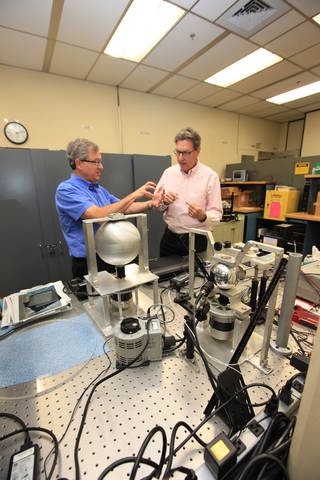 |
| June 13, 2017 | Volume 13 Issue 22 |
Designfax weekly eMagazine
Archives
Partners
Manufacturing Center
Product Spotlight
Modern Applications News
Metalworking Ideas For
Today's Job Shops
Tooling and Production
Strategies for large
metalworking plants
Electromagnets offer new options for satellite control
By Steven Siceloff, NASA's Kennedy Space Center, Florida
A group of NASA physicists at Kennedy Space Center may have uncovered an intriguing option for controlling a fleet of satellites or stopping an older satellite from tumbling out of control.

Physicists Bob Youngquist, left, and Stan Starr work with hollow and solid metal spheres in a laboratory at NASA's Kennedy Space Center in Florida where they are helping formulate principles of magnetic forces to see how they might be applied to spaceflight. [Credits: NASA/Kim Shiflett]
The research centers on electromagnetics and considers how simple devices might offer solutions to problems that have eluded engineers. For example, oscillating magnetic fields on adjacent spacecraft can be used to push and pull against each other and may prove a better steering mechanism in orbit than small thrusters that consume -- and eventually exhaust -- fuel. It may also present methods to make a series of small spacecraft perform as well or better than a single large spacecraft.
"Maybe instead of flying one big telescope, you fly a bunch of mirrors in formation and they form the telescope," said NASA's Stan Starr, one of the researchers. "You could have the same number of mirrors and spread them out to collect more light, or bring them together tightly to look at a specific area. You could change shape to refine the focus. The mirror of the telescope would be fully adaptable."
The findings could even lead to a spacecraft that lands on an asteroid without bouncing off it. Using magnetic forces, a spacecraft could simply connect to the asteroid similar to the way a magnet sticks to a refrigerator.
Delving into principles of electromagnetism first published in the 19th century, Starr, and Kennedy scientists Bob Youngquist, Ph.D., and Mark Nurge, Ph.D., explained that magnetic fields offer new opportunities in spaceflight because they can move themselves or other spacecraft without using fuel. On Earth, strong gravity and friction dwarf magnetic forces. But in orbit, relatively small magnetic forces over sufficient time can slow the spin of an object as big as a satellite.
"This ability to generate very weak forces is not very useful on the ground, but in orbit, long-term application of small forces can accumulate -- and that's where you can have a realm where these things are very applicable," Youngquist said. "There are other options, but this is a good one. This is a very promising area."
Some of the key work was performed early on by a German physicist named Heinrich Hertz, for whom the unit of frequency was named.
"It turns out that Hertz was the guy who addressed that in the 1880s," Youngquist said. "Most of it is archaic, done before modern calculus, so it's kind of like translating from another language when you read Hertz's work."
Joined by other researchers, including Mason Peck, NASA's former chief technologist, the trio of Kennedy researchers dug into landmark studies from the 19th century for the principles they set out to build upon.
After theorizing methods to control a fleet of satellites using magnetic waves, the team now is working on the formulas needed to stop defunct satellites from tumbling so they can be refurbished or refueled in orbit and returned to service. There may be a possibility of designing spacecraft that can use magnets to remove satellites from orbit to prevent the buildup of debris in space.
Until now, this technology has not been explored for spaceflight, largely because magnets can be quite heavy. However, innovations in power sources and other advances can lighten the mass so modern rockets can lift a workable spacecraft equipped with electromagnets. This is good news since space debris has become a concern with more and more satellites being launched into space every year.
Their work was recently featured on the cover of the March issue of the American Journal of Physics, an achievement compared to making the cover of Rolling Stone magazine.
The research was funded through NASA's Space Technology Mission Directorate Center Innovation Fund program, which stimulates and encourages creativity and innovation within NASA centers.
Published June 2017
Rate this article
View our terms of use and privacy policy
